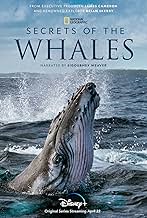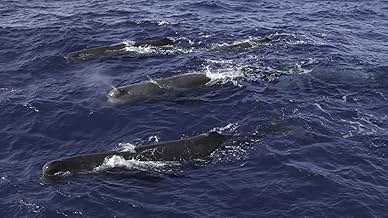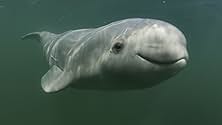VALUTAZIONE IMDb
8,4/10
1123
LA TUA VALUTAZIONE
Girata in 24 località in tre anni, questa saga si avventura nel mondo delle balene per rivelare la vita e l'amore dalla loro prospettiva ed esplora le culture di orche, beluga, narvali, capo... Leggi tuttoGirata in 24 località in tre anni, questa saga si avventura nel mondo delle balene per rivelare la vita e l'amore dalla loro prospettiva ed esplora le culture di orche, beluga, narvali, capodogli e megattere.Girata in 24 località in tre anni, questa saga si avventura nel mondo delle balene per rivelare la vita e l'amore dalla loro prospettiva ed esplora le culture di orche, beluga, narvali, capodogli e megattere.
- Vincitore di 1 Primetime Emmy
- 1 vittoria e 4 candidature totali
Sfoglia gli episodi
Recensioni in evidenza
Greetings again from the darkness. For many of us, our exposure to whales is limited to learning in school they are the largest mammals on Earth, and browsing travel guides displaying fantastic photographs of breeching whales alongside various tour excursions. National Geographic is on a mission to take us deeper into the world of these marvelous marine creatures. This 4-part docuseries is Executive Produced by Oscar-winning director James Cameron and award-winning photographer Brian Skerry, and was filmed over 3 years in multiple locations around the globe.
Episode One is titled "Orca Dynasty", and it explores communication and social structure that occurs within the family pod and community ... a recurring theme in each of the episodes, and across the five types of whales covered. Orcas, sometimes referred to as "killer whales", are the gorgeous black and white whales often featured at water parks ... although thankfully not as frequently as in the past. This segment takes us to New Zealand where we see the Orcas work together in hunting stingray, and utilize sophisticated sonar as their guide. We also follow them to the frigid water of the Arctic Ocean, as well as their confrontations with elephant seals in The Falklands.
Episode Two, "Humpback Song", features a baby learning to "speak", and again focuses on the culture and communication of the humpbacks. We witness these whales using their large brains for "bubblenet" fishing in Alaska - a highly coordinated effort that has been occurring for 40-plus years. The humpbacks breech and then slap their fin to communicate with each other. Their 'song of the sea' is featured in the Cook Islands, and we see the bonding that occurs between mother and calf. It's awe-inspiring to note that 100,000 whales from around the world simultaneously head to Antarctica for a krill buffet that results in each whale gaining up to 12 pounds an hour!
In Episode Three, "Beluga Kingdom", we follow along as these creamy white whales and their exceptionally social manner, adopt a stray narwhal whale into their pod so that it doesn't die alone. The narwhals are the most unusual looking whale in existence, even in comparison to the Belugas. With skin 100 times thicker than humans, Belugas are also known for group births, and generations of Belugas have spent one-third of their summers in Hudson Bay (Canada).
The fourth and final episode, "Ocean Giants" focuses on the massive sperm whales, best known as "Moby Dick". We learn their brains are six times larger than humans, and they use a Morse Code style clicking sound to communicate with each other. In Dominica (eastern Caribbean) we find 20 sperm whale families who deep dive to feed on 100 squid per day. This segment also includes the often tragic ramifications of human debris in the ocean, as sea turtles are entangled in discarded fishing nets.
Photography throughout the series is stunning and breath-taking. It takes us to places we never knew existed or might have previously only dreamt of. The only downside is the narration from Sigourney Weaver, whose lack of energy in reading, periodically gives this the sound of an old-school educational film. James Cameron provides an epilogue for each episode, but without a doubt, it's the fabulous creatures themselves that hold our attention. We find the Orcas, Humpbacks, Belugas, Narwhals, and Sperm Whales to be awe-inspiring and mesmerizing, and it's fascinating to learn how intricate and complex their social structures and cultures are. These intelligent giants of the sea draw us right into their world; and we are better off for it.
Disney+ original series Secrets of the Whales, from National Geographic, premieres Earth Day, April 22, 2021. The three-year project will also be featured in the new National Geographic book Secrets of the Whales, on sale April 6, and the May issue of National Geographic magazine, The Ocean Issue, available online on April 15.
Episode One is titled "Orca Dynasty", and it explores communication and social structure that occurs within the family pod and community ... a recurring theme in each of the episodes, and across the five types of whales covered. Orcas, sometimes referred to as "killer whales", are the gorgeous black and white whales often featured at water parks ... although thankfully not as frequently as in the past. This segment takes us to New Zealand where we see the Orcas work together in hunting stingray, and utilize sophisticated sonar as their guide. We also follow them to the frigid water of the Arctic Ocean, as well as their confrontations with elephant seals in The Falklands.
Episode Two, "Humpback Song", features a baby learning to "speak", and again focuses on the culture and communication of the humpbacks. We witness these whales using their large brains for "bubblenet" fishing in Alaska - a highly coordinated effort that has been occurring for 40-plus years. The humpbacks breech and then slap their fin to communicate with each other. Their 'song of the sea' is featured in the Cook Islands, and we see the bonding that occurs between mother and calf. It's awe-inspiring to note that 100,000 whales from around the world simultaneously head to Antarctica for a krill buffet that results in each whale gaining up to 12 pounds an hour!
In Episode Three, "Beluga Kingdom", we follow along as these creamy white whales and their exceptionally social manner, adopt a stray narwhal whale into their pod so that it doesn't die alone. The narwhals are the most unusual looking whale in existence, even in comparison to the Belugas. With skin 100 times thicker than humans, Belugas are also known for group births, and generations of Belugas have spent one-third of their summers in Hudson Bay (Canada).
The fourth and final episode, "Ocean Giants" focuses on the massive sperm whales, best known as "Moby Dick". We learn their brains are six times larger than humans, and they use a Morse Code style clicking sound to communicate with each other. In Dominica (eastern Caribbean) we find 20 sperm whale families who deep dive to feed on 100 squid per day. This segment also includes the often tragic ramifications of human debris in the ocean, as sea turtles are entangled in discarded fishing nets.
Photography throughout the series is stunning and breath-taking. It takes us to places we never knew existed or might have previously only dreamt of. The only downside is the narration from Sigourney Weaver, whose lack of energy in reading, periodically gives this the sound of an old-school educational film. James Cameron provides an epilogue for each episode, but without a doubt, it's the fabulous creatures themselves that hold our attention. We find the Orcas, Humpbacks, Belugas, Narwhals, and Sperm Whales to be awe-inspiring and mesmerizing, and it's fascinating to learn how intricate and complex their social structures and cultures are. These intelligent giants of the sea draw us right into their world; and we are better off for it.
Disney+ original series Secrets of the Whales, from National Geographic, premieres Earth Day, April 22, 2021. The three-year project will also be featured in the new National Geographic book Secrets of the Whales, on sale April 6, and the May issue of National Geographic magazine, The Ocean Issue, available online on April 15.
Secrets of the Whales
With Sigourney Weaver's soothing voice, excellent cinematography, and education on these majestic creatures, this Nat Geo miniseries shows off Orcas, Humpbacks, Belugas, Narwhals and Sperm Whales up close and personal. They do show them feeding, but from a distance, and not the super gory way it truly is. I felt bad for those poor sea lions.
The footage from underwater is just so cool to see. The divers did a really good job for those shots.
I mean, it's a documentary about whales, so it's pretty straightforward, but I enjoyed seeing the creatures that are usually seen from a distance.
With Sigourney Weaver's soothing voice, excellent cinematography, and education on these majestic creatures, this Nat Geo miniseries shows off Orcas, Humpbacks, Belugas, Narwhals and Sperm Whales up close and personal. They do show them feeding, but from a distance, and not the super gory way it truly is. I felt bad for those poor sea lions.
The footage from underwater is just so cool to see. The divers did a really good job for those shots.
I mean, it's a documentary about whales, so it's pretty straightforward, but I enjoyed seeing the creatures that are usually seen from a distance.
Each episode was beautifully produced and narrated but I was absolutely shocked that National Geographic presented an episode that refers to the Orca/"Killer Whale" as a whale. It's not a whale. It's the largest Dolphin, which is an entirely different animal.
I read a lot of the other reviews and noted almost every one of them commented on how much they learned. Wouldn't it be better to have said from the top that it's called the Killer Whale but it isn't actually a whale. Makes me wonder what else they put in the series that isn't correct.
National Geographic is known for it's gold standard. Why would you let this one slip through? Or did you reclassify the Orca without announcing it?
I read a lot of the other reviews and noted almost every one of them commented on how much they learned. Wouldn't it be better to have said from the top that it's called the Killer Whale but it isn't actually a whale. Makes me wonder what else they put in the series that isn't correct.
National Geographic is known for it's gold standard. Why would you let this one slip through? Or did you reclassify the Orca without announcing it?
Shame. Mostly monosyllable kindergarten repetitive script is poorly delivered by narrator Sigourney Weaver - a good actress but not narrator. Thus, the interesting, indeed some enchanting rare photography and music score are ruined.
James Cameron is executive producer. He should have narrated as his voice displays genuine respect & fascination of whales in one bonus feature as he watches the highlights of film.
Instead of paying Sigourney Weaver high wage, use the money for a better script with more intelligent/Interesting facts & narrator with an interesting voice.
This show had great possibilities , showing true hidden nature & intelligence of whales, proving common myths wrong, showing culture & traditions. Yet, it's the narration that separates the "must see" ones. It's why elder Sir David is beloved- his vocal TONE & delivery remains entertaining, plus he mostly had well written scripts. Tom Hiddleston (Loki) is another with great voice and delivery. Comedian Tim Allen (Bud Lightyear in Toy Story films) did fine narration of chimps for Disney. Bill Murrey is another with great voice & timing ( Baloo in Jungle book).
No music score is needed when photography is fascinating, only natural sounds of whales & oceans. But constant narration of wrong voice can ruin best filmography.
Preteens & older will become bored with this series.
James Cameron is executive producer. He should have narrated as his voice displays genuine respect & fascination of whales in one bonus feature as he watches the highlights of film.
Instead of paying Sigourney Weaver high wage, use the money for a better script with more intelligent/Interesting facts & narrator with an interesting voice.
This show had great possibilities , showing true hidden nature & intelligence of whales, proving common myths wrong, showing culture & traditions. Yet, it's the narration that separates the "must see" ones. It's why elder Sir David is beloved- his vocal TONE & delivery remains entertaining, plus he mostly had well written scripts. Tom Hiddleston (Loki) is another with great voice and delivery. Comedian Tim Allen (Bud Lightyear in Toy Story films) did fine narration of chimps for Disney. Bill Murrey is another with great voice & timing ( Baloo in Jungle book).
No music score is needed when photography is fascinating, only natural sounds of whales & oceans. But constant narration of wrong voice can ruin best filmography.
Preteens & older will become bored with this series.
We watched this together as a family show. It was gentle enough for the little one to watch and not be scared. There were a couple scenes, one included a dead orca calf, which was a little to much for her to bare. But other than that it was fine for her.
It is very interesting, we learned a ton of new things about the different species of whales. Sigourney Weaver does a great job narrating. The pacing is really good, here it switches between footage of the whales and the scientists studying them, but it's mostly whale footage.
Totally recommend for anyone interested in nature documentaries.
It is very interesting, we learned a ton of new things about the different species of whales. Sigourney Weaver does a great job narrating. The pacing is really good, here it switches between footage of the whales and the scientists studying them, but it's mostly whale footage.
Totally recommend for anyone interested in nature documentaries.
Lo sapevi?
- ConnessioniFeatured in AniMat's Crazy Cartoon Cast: The Rat of All My Dreams (2020)
I più visti
Accedi per valutare e creare un elenco di titoli salvati per ottenere consigli personalizzati
- How many seasons does Secrets of the Whales have?Powered by Alexa
Dettagli
- Data di uscita
- Paese di origine
- Sito ufficiale
- Lingua
- Celebre anche come
- Secrets of the Whales
- Luoghi delle riprese
- Aziende produttrici
- Vedi altri crediti dell’azienda su IMDbPro
- Tempo di esecuzione3 ore 11 minuti
- Colore
- Mix di suoni
- Proporzioni
- 16:9 HD
Contribuisci a questa pagina
Suggerisci una modifica o aggiungi i contenuti mancanti

Divario superiore
What is the Japanese language plot outline for I segreti delle balene (2021)?
Rispondi


























